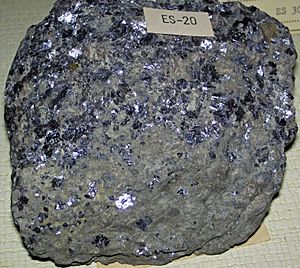Bonneterre Formation facts for kids
Quick facts for kids Bonneterre FormationStratigraphic range: Guzhangian (Dresbachian) ~501–497Ma |
|
|---|---|

Galena in Bonneterre Dolomite (Upper Cambrian; Missouri)
|
|
| Type | Formation |
| Underlies | Davis Formation |
| Overlies | Lamotte Sandstone |
| Lithology | |
| Primary | Dolomite |
| Other | Shale, limestone, sandstone |
| Location | |
| Coordinates | 37°38′10″N 90°34′41″W / 37.636°N 90.578°W |
| Approximate paleocoordinates | 22°54′S 86°30′W / 22.9°S 86.5°W |
| Region | Illinois, Minnesota & Missouri |
| Country | |
The Bonneterre Formation is a special type of rock layer. It is found in the St. Francois Mountains of Missouri, USA. This rock formed a very long time ago, during a period called the Upper Cambrian.
The Bonneterre Formation is important because it holds a lot of lead metal. This lead is found in what is known as the Missouri Lead Belt.
Contents
Where the Rock Sits
This rock layer rests on top of another rock. That rock is called the Lamotte Sandstone. In some places, the Bonneterre Formation sits directly on much older Proterozoic igneous rocks. These igneous rocks form the core of the mountains.
The Bonneterre Formation is covered by the Davis Formation. In the areas where it is visible, the Bonneterre is usually about 375 to 400 feet thick. But underground in Pemiscot County, it can be as thick as 1,580 feet!
What the Rock is Made Of
The Bonneterre Formation is mostly made of a rock called dolomite. It also has areas or layers of pure limestone.
The lower part of the formation has a shaley zone. This zone sometimes contains a green mineral called glauconite. At the very bottom, where it meets the older rocks, you can find sand and conglomerate or breccia. These are rocks made of smaller pieces cemented together.
Ancient Life in the Rocks
Scientists have found fossils in the Bonneterre Formation. These fossils tell us about the ancient creatures that lived when the rock was forming.
Monoplacophora Fossils
Monoplacophora were a type of ancient sea creature. They looked a bit like snails.
- Hypseloconus bonneterrense
- Irondalia
- I. irondalensis
- Kirengella washingtonense
- Ulrichoconus
- U. bonneterrense
Trilobite Fossils
Trilobites were ancient sea animals with hard shells. They are now extinct.
- Kingstoniidae
- Blountia sp.
- Tricrepicephalidae
- Tricrepicephalus sp.
Gastropod Fossils
Gastropods are a group of animals that include snails and slugs. These are ancient snail-like creatures.
- Tropidodiscidae
- Strepsodiscus major

